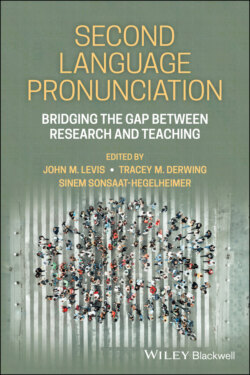Читать книгу Second Language Pronunciation - Группа авторов - Страница 17
Where to Start
ОглавлениеThis volume is rich with ideas from research that can inform pronunciation instruction in the classroom. Empirical studies offer extremely helpful ideas to teachers, and they provide insights as to why certain activities will have beneficial outcomes. However, knowing about some new activities and understanding why they may be useful is likely not enough to encourage a teacher who has not had any training in pronunciation to try implementing some of these ideas. The first step is always to determine where students’ pronunciation problems lie, and this is often the most difficult.
We suggest not doing this alone; a new endeavor will be easier to undertake with one or two colleagues. In one of the first classes in a language course, students should be asked to send a short (2–3 minutes) recording to their teacher on an easy topic such as “My favorite food” or “my happiest moment” or “my daily routine.” Teachers could also ask their students to describe a picture and send the recording. To assess where intelligibility and comprehensibility problems lie, two or three teachers should listen to these recordings together. Listening for specific aspects of speech helps to isolate problems – “once for overall comprehensibility, once for word stress, once for sentence stress, once for vowels, and finally consonants” (Derwing, in press). When each student’s most difficult problems have been identified, it is time to make a plan for both in-class and homework activities. (Note that some students may not have any features in their speech that interfere with comprehensibility.) If several students share specific difficulties, then classroom activities can be considered (often suprasegmentals will fall into this category). If individual students are struggling with certain segments, the teacher must then determine if the problem is related to perception, production, or both by doing a simple perception test. For example, if a student produces a /b/ where a /p/ is warranted, teachers can display a minimal pair, and produce one of the words. If the students can perceive correctly, then their problem is strictly production. If they cannot, then explicit explanation, along with listening practice can be introduced. Much of the listening practice can be done at home on a website such as English Accent Coach (Thomson, 2021) and students’ scores can be forwarded to the instructor.
This may seem like a daunting undertaking, but it is far less onerous if two or more teachers do it together. To trace their learners’ progress, teachers may want to conduct an informal action research project. Burns (2009) provides guidelines on how classroom teachers can systematically keep track of pronunciation activities, ensuring spiraling for optimal exposure. Burns provides a very clear example of one language teacher’s approach to action research that follows a cycle of “planning, action, observation and reflection” (115). It isn’t necessary to undertake action research, but reading about the process may provide teachers with ideas for structure that hadn’t occurred to them before.
We hope that the chapters here will bridge the gap for teachers who are uncomfortable teaching pronunciation in the language classroom. In the words of Yates and Zielinski, “Give it a go!”
